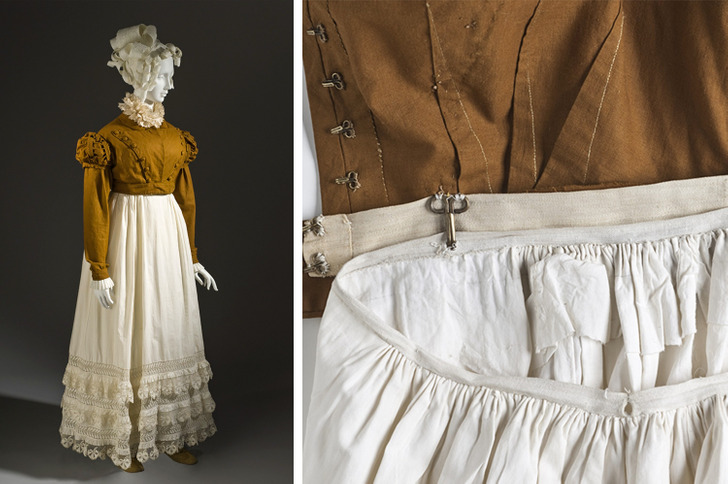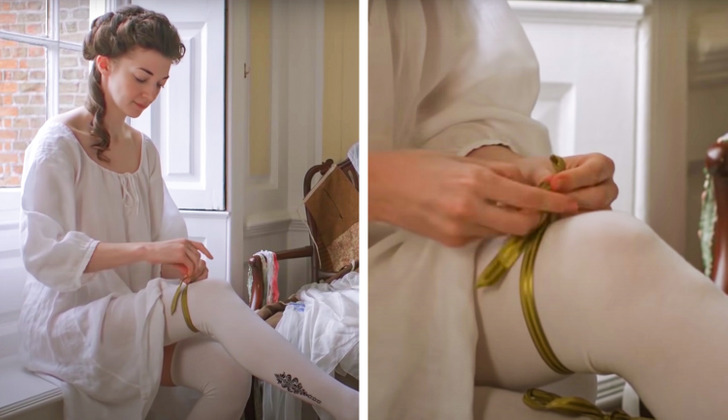9 Fashion Secrets From Noble People That Tell About History More Than Books and Documentaries

Fashion is the mirror of time. The values and standards of the time they are worn in are captured in fashion. Noble French, British, and Spanish women of the past amaze us with the beauty of their dresses. But few people know that the dresses from noble people of the past had their own little secrets.
The cross-section crease on the dress helped adjust its length.
Spanish dresses from the Renaissance era have an interesting feature. It’s the barely visible cross-section crease on the hem of the dress, below the knee, and above the ankle. You can see it in the portraits of Spanish ladies from the 16th century. For example, the daughter of Philip II, Isabella Clara Eugenia, wore dresses with this crease both when she was a child and as an adult. There’s a theory that the extra fabric allowed people to change the length of the dress as the girls grew up.
Secret grips for the skirt allowed women to move easier in dresses with a train.
At the end of the 19th century, dresses with trains became popular. They looked great but they weren’t always comfortable. In order to not limit the mobility of women, there were special grips on the sides. Long skirts could be lifted and fixed without anyone seeing anything. This trick created more draping, kept the look consistent, and made women’s lives much easier.
Wide hoops under skirts made a woman’s waist look smaller.
In the 18th century, when the Rococo style was popular, hoops under dresses became popular again. They were light and worn with long gowns and loose skirts with wide creases. Another type of hoop, called a pannier, allowed women to have the trendy silhouette of the time — an inverted glass. Thin waist, straight shoulders, and a glass-looking skirt created the association.
The contrast between the waist and the skirt was important for 2 reasons. First, it showed that the woman was fit. Her extra weight was hidden: the corsets were used not to highlight the body’s features but hide them. It kept the belly fit and supported the back. Because the tightened waist looked even thinner together with the pannier, the effect was even stronger. Second, the wider the skirt was, the richer its owner looked. Poor women wore starched skirts.
Pillows were put into sleeves to highlight the waist.
The ladies of the 19th century preferred dresses with big voluminous sleeves. Down pillows were put inside the sleeves and tied to the dress. Large sleeves made a thin line look even better and were quite popular among noble trendy women.
The waistline said a lot about how trendy a woman was.
In 1815, England started following French fashion trends: women started wearing dresses with a high waistline. The waistline got to its peak in 1816-1817, right below the chest. Almost right after that, in 1818, it started going down, about an inch a year until it reached its normal position by 1825.
Long gloves were needed to hide sharp elbows
Throughout the Victorian era, ladies and gentlemen paid a lot of attention to the elbows. This part of the body was considered beautiful and attractive only if the elbows were rounded. There were no strict rules regarding the length of the gloves. So women, who had sharp elbows were recommended to glove them or hide under their sleeves. Lucky ladies with round elbows could easily expose them, as it was considered a sign of good taste.
Spencer jacket
A Spencer is a ladies’ jacket with long sleeves. Initially, Spencers were short coats men wore on top of their main outwear. According to the legend, Earl Spencer was the creator of this piece of clothing. He accidentally burned the lower parts of his coat which contributed to the short shape.
From the 1790s to 1820s, Spencers became popular among women. They wore them on top of muslin dresses to keep warm. The length of the jacket depended on the height of the skirt: it was important for the jacket to end right at the waistline. The skirt was attached to the jacket from the inside with special hooks.
Ribbon-garters
Women wore stockings above the knee. They were made of wool, cotton, silk, or a mix of these fabrics. Around the ankle, the stockings were decorated with patterns. Satin ribbons were tied above the knee to keep the stockings in place and if a lady was going for a walk or to a dance, the ribbons were placed under the knee.
Pantaloons
Thin and soft muslin dresses of the 1800s were fairly tight and showed off the natural outlines of the body. These dresses were basically nightgowns. In order to keep warm, ladies needed warm underwear. The pantaloons men already wore back then were quite useful for women too.
At the beginning, the length was around the ankles or just below the knee. The distinctive feature of the first ladies’ pantaloons was separated pantlegs. They were attached to a belt on the waist and not tied to each other. They were made of thin body-color knitwear fabric. Maybe, this is the reason why women of this time period were often shown without underwear.
Which of these garments do you think was the most uncomfortable?








